Chinese Journal of Computational Physics ›› 2023, Vol. 40 ›› Issue (2): 210-221.DOI: 10.19596/j.cnki.1001-246x.8609
Special Issue: 贺贤土院士从事科学研究工作60周年暨激光聚变相关研究进展专刊
• The 60th Anniversary of Academician He Xiantu's Scientific Research Work: A Special Issue of Research Progress in Laser Fusion • Previous Articles Next Articles
Zhimeng ZHANG( ), Wei QI, Bo CUI, Bo ZHANG, Wei HONG, Weimin ZHOU*(
), Wei QI, Bo CUI, Bo ZHANG, Wei HONG, Weimin ZHOU*( )
)
Received:2022-08-12
Online:2023-03-25
Published:2023-07-05
Contact:
Weimin ZHOU
Zhimeng ZHANG, Wei QI, Bo CUI, Bo ZHANG, Wei HONG, Weimin ZHOU. Hybrid Particle-in-cell/Fluid Method for Intense Ion Beam Transport in Solid Plasmas[J]. Chinese Journal of Computational Physics, 2023, 40(2): 210-221.
Add to citation manager EndNote|Ris|BibTeX
URL: http://www.cjcp.org.cn/EN/10.19596/j.cnki.1001-246x.8609
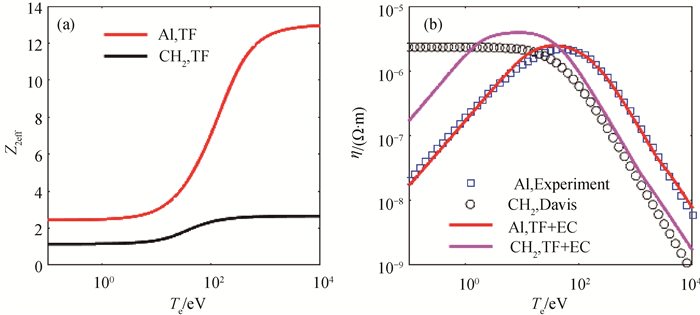
Fig.1 (a) Averaged ionization and (b) resistivity of solid aluminum Al and polyethylene CH2 (Here ks =Av =0.2 are adopted for Al while they are ks =2 and Av =10 for CH2.)
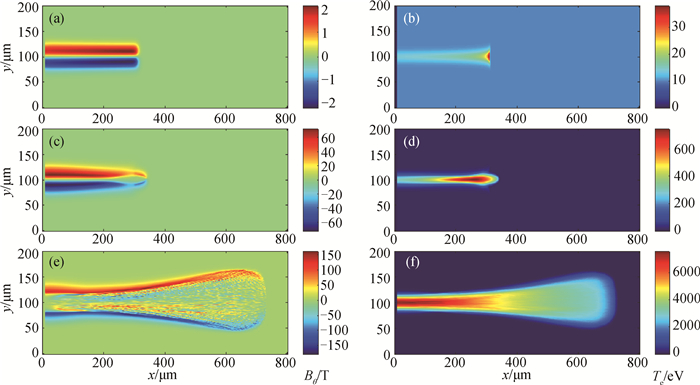
Fig.2 The spatial distribution of the magnetic field Bθ and the target temperature Te at t=30 ps, which are caused by the 5 MeV collimated proton beam propagates into the solid CH2 target. The proton current densities are (a)~(b) 109 A·cm-2, (c)~(d) 1011 A·cm-2 and (e)~(f) 1013 A·cm-2
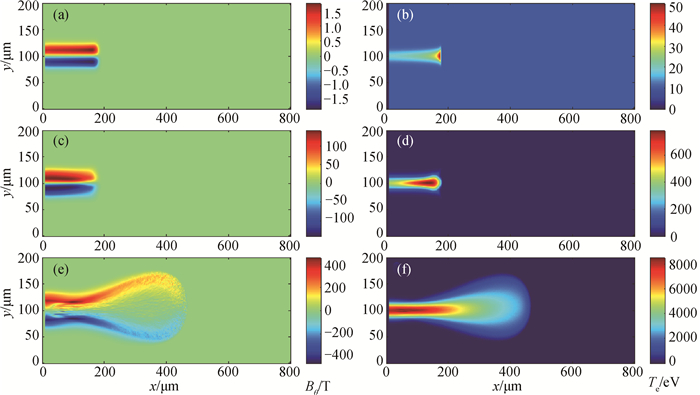
Fig.3 The spatial distribution of the magnetic field Bθ and the target temperature Te at f = 30 ps, which are caused by the 5 MeV collimated proton beam propagates into the solid Al target. The proton current densities are (a)~(b) 109 A·cm-2, (c)~(d) 1011 A·cm-2 and (e)~(f) 1013 A·cm-2
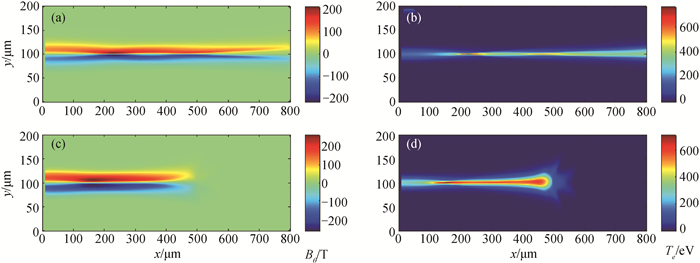
Fig.4 The spatial distribution of the magnetic field Bθ and the target temperature Te at t = 30 ps, which are caused by the 10 MeV collimated proton beam propagates into the solid targets. The proton beam has a waist of 10 μm. The target materials are (a)~(b) CH2 and (c)~(d) Al.
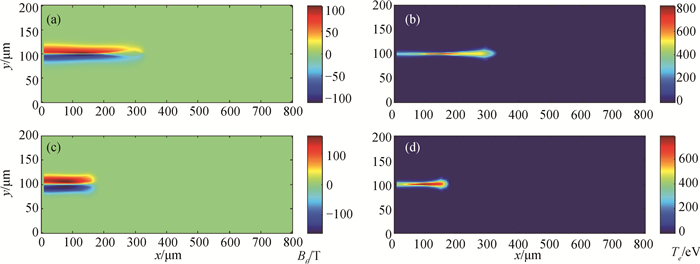
Fig.5 The spatial distribution of the magnetic field Bθ and the target temperature Te at t = 30 ps, which are caused by the 5 MeV collimated proton beam propagates into the solid targets. The proton beam has a current density of 1011 A·cm-2 and a waist of 5 μm. The target materials are (a)~(b) CH2 and (c)~(d) Al.
| 1 |
DOI |
| 2 |
DOI |
| 3 |
DOI |
| 4 |
DOI |
| 5 |
|
| 6 |
DOI |
| 7 |
DOI |
| 8 |
DOI |
| 9 |
|
| 10 |
DOI |
| 11 |
DOI |
| 12 |
DOI |
| 13 |
DOI |
| 14 |
DOI |
| 15 |
DOI |
| 16 |
DOI |
| 17 |
|
| 18 |
DOI |
| 19 |
|
| 20 |
DOI |
| 21 |
|
| 22 |
DOI |
| 23 |
|
| 24 |
DOI |
| 25 |
DOI |
| 26 |
DOI |
| 27 |
DOI |
| 28 |
DOI |
| 29 |
DOI |
| 30 |
DOI |
| 31 |
|
| 32 |
DOI |
| 33 |
DOI |
| 34 |
DOI |
| 35 |
|
| 36 |
|
| 37 |
|
| 38 |
DOI |
| 39 |
|
| 40 |
DOI |
| 41 |
DOI |
| 42 |
DOI |
| 43 |
DOI |
| [1] | SUN Min-de, LIU Bo, SHI Xian-feng, SHEN Hao, MI Yong. OMPUTER SIMULATION OF STIM [J]. CHINESE JOURNAL OF COMPUTATIONAL PHYSICS, 2002, 19(2): 183-188. |
| [2] | Tan Zhenyu, He Yancai. STOPPING POWER FOR INELASTIC SCATTERING OF LOW-ENERGY ELECTRON [J]. CHINESE JOURNAL OF COMPUTATIONAL PHYSICS, 1995, 12(3): 315-319. |
| [3] | Wang Younian, Ma Tengcai. NUMERICAL CALCULATIONS OF STOPPING POWERS AND ENERGY STRAGGLINGS FOR IONS IN A STRONGLY COUPLED DEGENERATE ELECTRON GAS [J]. CHINESE JOURNAL OF COMPUTATIONAL PHYSICS, 1990, 7(2): 235-240. |
| Viewed | ||||||
|
Full text |
|
|||||
|
Abstract |
|
|||||
Copyright © Chinese Journal of Computational Physics
E-mail: jswl@iapcm.ac.cn
Supported by Beijing Magtech Co., Ltd.
